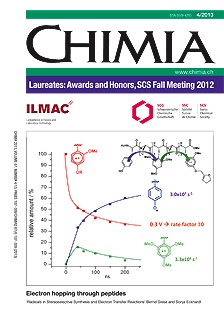Precision Measurements of Ionization and Dissociation Energies by Extrapolation of Rydberg Series: From H2 to Larger Molecules
DOI:
https://doi.org/10.2533/chimia.2013.257Keywords:
High-resolution spectroscopy, Molecular hydrogen, Rydberg states, ThermochemistryAbstract
Recent experiments are reviewed which have led to the determination of the ionization and dissociation energies of molecular hydrogen with a precision of 0.0007 cm–1 (8 mJ/mol or 20 MHz) using a procedure based on high-resolution spectroscopic measurements of high Rydberg states and the extrapolation of the Rydberg series to the ionization thresholds. Molecular hydrogen, with only two protons and two electrons, is the simplest molecule with which all aspects of a chemical bond, including electron correlation effects, can be studied. Highly precise values of its ionization and dissociation energies provide stringent tests of the precision of molecular quantum mechanics and of quantum-electrodynamics calculations in molecules. The comparison of experimental and theoretical values for these quantities enable one to quantify the contributions to a chemical bond that are neglected when making the Born-Oppenheimer approximation, i.e. adiabatic, nonadiabatic, relativistic, and radiative corrections. Ionization energies of a broad range of molecules can now be determined experimentally with high accuracy ( i.e. about 0.01 cm–1). Calculations at similar accuracies are extremely challenging for systems containing more than two electrons. The combination of precision measurements of molecular ionization energies with highly accurate ab initio calculations has the potential to provide, in future, fully reliable sets of thermochemical quantities for gas-phase reactions.Downloads
Published
2013-04-24
Issue
Section
Scientific Articles
License
Copyright (c) 2013 Swiss Chemical Society

This work is licensed under a Creative Commons Attribution-NonCommercial 4.0 International License.
How to Cite
[1]
D. Sprecher, M. Beyer, F. Merkt, Chimia 2013, 67, 257, DOI: 10.2533/chimia.2013.257.







